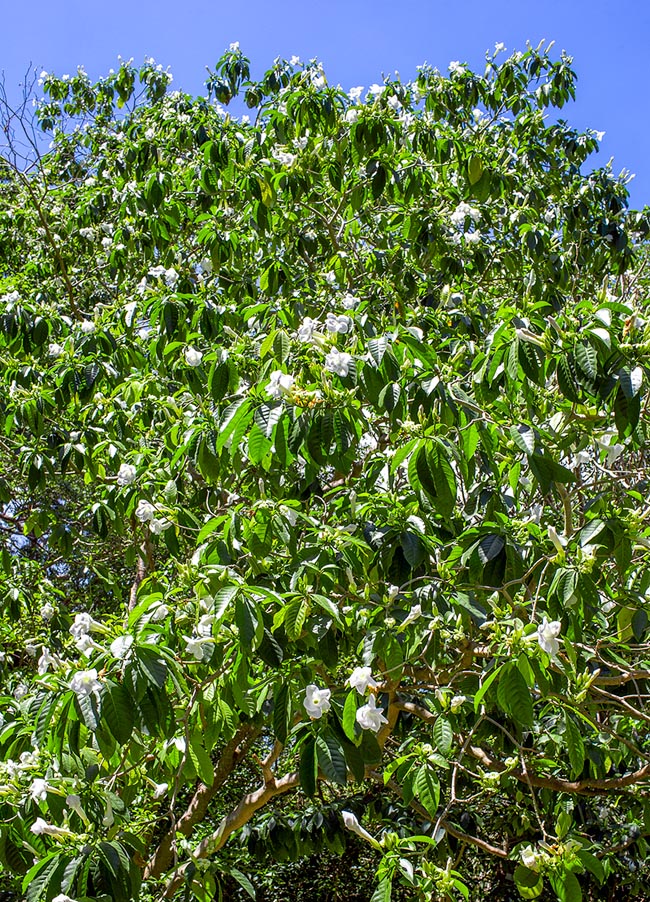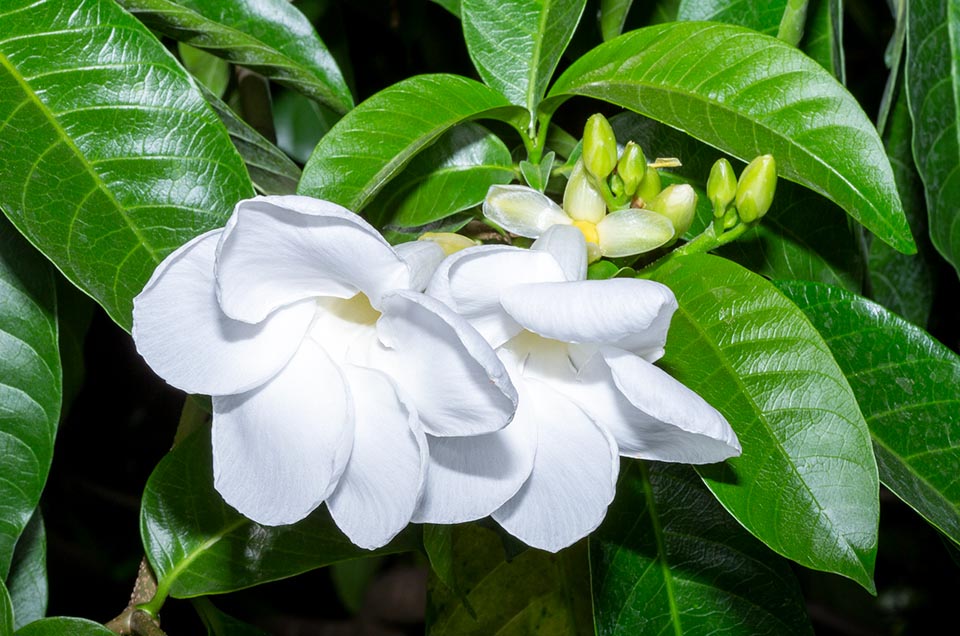Family : Apocynaceae

Text © Pietro Puccio

English translation by Mario Beltramini

The Tabernaemontana litoralis is 3-12 m tall shrub or small evergreen tree of Central America © Giuseppe Mazza
The species is native to Colombia, Costa Rica, Guatemala, Honduras, Mexico (Baja California Sur, Campeche, Chiapas, Colima, Guerrero, Hidalgo, Jalisco, México, Michoacán, Morelos, Nayarit, Oaxaca, Puebla, Quintana Roo, Tabasco, Veracruz and Yucatan), Nicaragua and Panama where it grows in the forests and humid tropical thickets, up to about 1800 m of altitude.
The genus is honoured to the German physician and botanist Jakob Theodor Müller von Bergzabern (ca 1520-1590), Tabernaemontanus is the Latinized name of Bergzabern; the specific name is the Latin adjective “litoralis, e” = littoral, with reference to the presence along the coasts of the type species.
Common names: milky way tree (English); azuceno, cojón de fraile (Colombia); bijarro, cojón de burro, cojón de caballo, guijarro, huevos de caballo (Costa Rica); cojón, cojón de caballo, ixdislan, ixlao (Guatemala); guijarro, huevos de gato, laurel, lechoso, xlaul (Mexico).
The Tabernaemontana litoralis Kunth (1819) is a shrub or small evergreen tree, 3-12 m tall, with trunk, of 25-30 cm of diameter,with greyish bark tending to fissure vertically with the age, and dichotomous branches; the plant produces an abundant milky sap.
The leaves, on a 0,5-2 cm long petiole, are simple, opposite, oblong-elliptic with subacuminate apex and entire margin, of glossy intense green colour above, paler below, 8,5-22 cm long and 3,5-8 cm broad.
Terminal inflorescences, on a 2-4 cm long peduncle, with 2-6 flowers, 4,5-6,5 cm long and of 6-7,5 cm of diameter, of pure white colour with yellow throat. Calyx with 5 oblong-elliptic unequal lobes with obtuse apex, 0,5-1 cm long, hypocrateriform corolla (with spread lobes perpendicular to a long tube) with 5 obovate lobes, rounded and partially overlapping, 3-4 cm long and 3,5-4,5 cm broad.
The fruits are follicles in couple shaped like cloves with acute apex, 5-6 cm long and 3-4 cm broad, initially green, then orange when ripe, containing 30-40 seeds of dark brown colour, about 1 cm long, covered by a fleshy aril of red orange colour. It reproduces by seed, that has a short germination time, in organic draining loam maintained humid at the temperature of 24-28 °C, but usually and easily by air layering and cutting. One of the most ornamental species among the Apocynaceae, but fairly rare in cultivation, with glossy foliage and abundant blooming, produced for most of the year, that emits a slight sweet fragrance that intensifies during the night hours.
Cultivable as isolated specimen, in group or at the margin of the avenues, in the tropical and humid subtropical regions characterized by high rainfall distributed during the year, as it does not stand long lasting dry periods, and averagely high temperatures, values just less than 0 °C, even if of very short duration, may seriously damage the crown.

The flowers, with stronger scent in the night hours, are pure white with yellow throat. The 6-7,5 cm broad corolla, has 5 partially overlapped lobes perpendicular to a long tube. Species rare in cultivation, suitable only to the gardens of the tropical and humid subtropical regions. All parts of the plant are highly poisonous © Giuseppe Mazza
It requires full sun or partial shade and draining soils rich of organic substance, slightly acidic to slightly alkaline, maintained almost constantly humid, moreover it tolerates the salty winds and therefore can be employed in gardens close to the sea. It stands well the pruning and can be grown in a capacious container in order to be sheltered, in the colder climates, in a luminous environment with lowest temperatures not under the 15 °C.
Like other species of the family, all parts of the plant are highly poisonous.
Synonyms: Odontostigma galeottianum A.Rich. (1850); Echites bignoniiflorus Schltdl. (1854); Peschiera litoralis (Kunth) Miers (1878); Stemmadenia bella Miers (1878); Stemmadenia bignoniiflora (Schltdl.) Miers (1878); Stemmadenia galeottiana (A.Rich.) Miers (1878); Stemmadenia insignis Miers (1878); Tabernaemontana laurifolia Schott ex Miers (1878); Stemmadenia macrophylla Greenm. (1900); Stemmadenia greenmanii Woodson (1928); Stemmadenia litoralis (Kunth) L.Allorge (1985).
→ To appreciate the biodiversity within the APOCYNACEAE family please click here.
